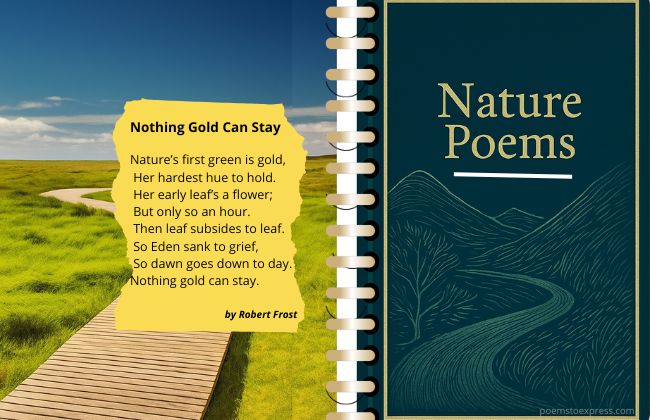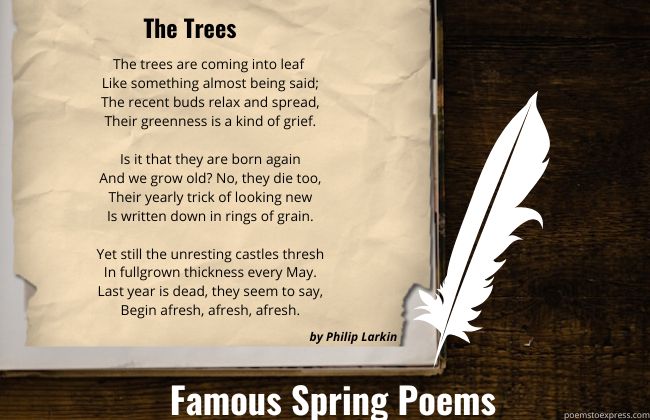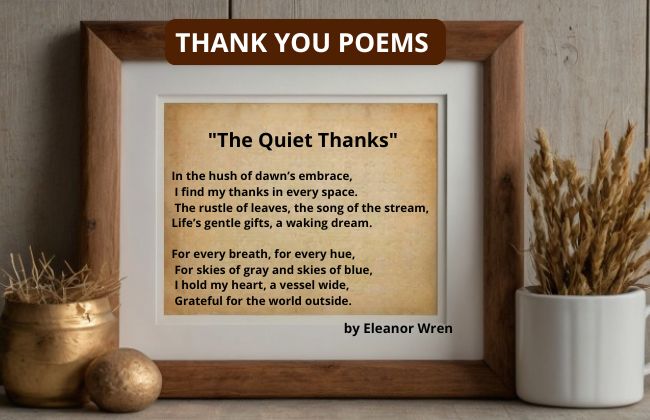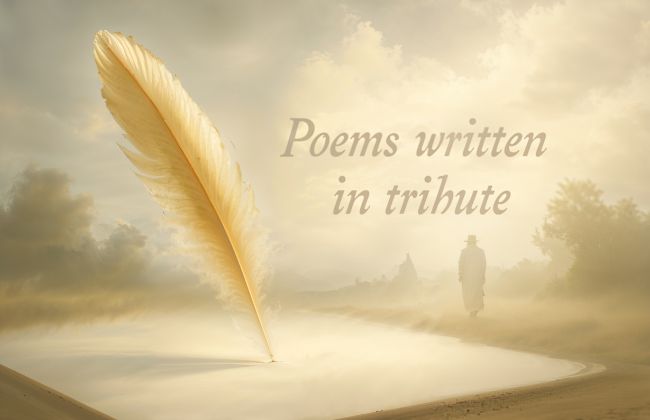Walt Whitman stands as a towering figure in American literature, celebrated for his groundbreaking approach to poetry and his ability to capture the spirit of a young, evolving nation.

Known as the “bard of democracy,” Whitman broke away from traditional poetic structures, employing free verse to create a voice that was uniquely his own.
His work embraced themes of individuality, nature, love, and the interconnectedness of humanity, often blurring the lines between the personal and the universal.
Through his verses, Whitman expressed an unyielding optimism and a profound appreciation for the human experience in all its forms.
His seminal collection, Leaves of Grass, marked a radical departure from convention, inspiring generations of poets to follow their own paths.
This post explores ten of Whitman’s greatest poems—works that showcase his genius, his empathy, and his enduring legacy. Join us as we unpack the words and ideas that make him a poet whose voice still resonates today.
Table of Contents
- 1 1) “O Captain! My Captain!”
- 2 2) “Song of Myself”
- 3 3) “I Sing the Body Electric”
- 4 4) “When Lilacs Last in the Dooryard Bloom’d”
- 5 6) “A Noiseless Patient Spider”
- 6 7) “Out of the Cradle Endlessly Rocking”
- 7 8) “The Wound-Dresser”
- 8 9) “There Was a Child Went Forth”
- 9 10) “I Hear America Singing”
- 10 Understanding Walt Whitman’s Literary Style
- 11 Exploring Whitman’s Influence on American Poetry
1) “O Captain! My Captain!”
“O Captain! My Captain!” is perhaps one of the most famous poems by Walt Whitman. Composed as an elegy to Abraham Lincoln following his assassination in 1865, the poem captures the nation’s grief through a metaphor of a ship’s captain who dies just as the journey reaches its peaceful conclusion.
The poem stands out in Whitman’s oeuvre for its structured rhyme and meter, contrasting his usual free verse style.
The work is composed of three eight-line stanzas and holds a place in American cultural memory, often highlighted in educational settings.
Despite its patriotic tone, there is a palpable sense of loss that resonates with readers, reflecting the collective mourning of a nation for its leader.
O Captain! my Captain! our fearful trip is done,
The ship has weather’d every rack, the prize we sought is won,
The port is near, the bells I hear, the people all exulting,
While follow eyes the steady keel, the vessel grim and daring;
But O heart! heart! heart!
O the bleeding drops of red,
Where on the deck my Captain lies,
Fallen cold and dead.
O Captain! my Captain! rise up and hear the bells;
Rise up—for you the flag is flung—for you the bugle trills,
For you bouquets and ribbon’d wreaths—for you the shores a-crowding,
For you they call, the swaying mass, their eager faces turning;
Here Captain! dear father!
This arm beneath your head!
It is some dream that on the deck,
You’ve fallen cold and dead.
My Captain does not answer, his lips are pale and still,
My father does not feel my arm, he has no pulse nor will,
The ship is anchor’d safe and sound, its voyage closed and done,
From fearful trip the victor ship comes in with object won;
Exult O shores, and ring O bells!
But I with mournful tread,
Walk the deck my Captain lies,
Fallen cold and dead.
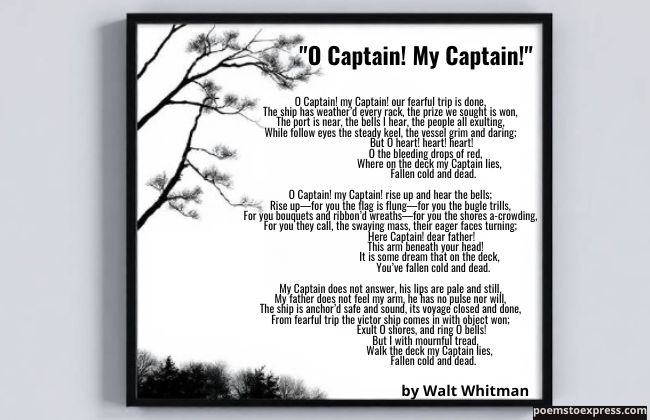
2) “Song of Myself”
“Song of Myself” stands as a central piece in Walt Whitman’s literary oeuvre. It is an extensive, multi-part poem first published in “Leaves of Grass” in 1855.
The poem is deeply rooted in the exploration and celebration of the individual. Whitman uses a free verse structure, which was revolutionary at the time, to give a voice to a distinctly American spirit.
In this poem, Whitman casts himself as the narrator who communes with nature and society. The poet’s use of repetition, anaphora, and a stream-of-consciousness style contributes to the immersive experience of the poem.
“Song of Myself” is recognized for its themes of democracy, the self, and the transcendental belief in a collective human spirit.
1
I celebrate myself, and sing myself,
And what I assume you shall assume,
For every atom belonging to me as good belongs to you.
I loafe and invite my soul,
I lean and loafe at my ease observing a spear of summer grass.
My tongue, every atom of my blood, form’d from this soil, this air,
Born here of parents born here from parents the same, and their parents the same,
I, now thirty-seven years old in perfect health begin,
Hoping to cease not till death... See full poem
3) “I Sing the Body Electric”
Initially untitled when it first appeared in the 1855 edition of “Leaves of Grass,” it later formed part of the “Children of Adam” cluster of poems. Whitman revised the poem, giving it its famous title in the 1867 edition where it featured as a complete work.
The poem contains nine sections, where Whitman presents the body and soul as unified entities, challenging the prevailing Christian doctrine that saw the body as corruptible and separate from the soul. He embraces a physical spirituality that sees every part of the human anatomy as imbued with divine significance.
Through a series of vibrant images and candid examinations of the body, Whitman underscores the beauty innate to every individual, linking physical existence to the cosmos itself.
I sing the body electric,
The armies of those I love engirth me and I engirth them,
They will not let me off till I go with them, respond to them,
And discorrupt them, and charge them full with the charge of the soul.
Was it doubted that those who corrupt their own bodies conceal themselves?
And if those who defile the living are as bad as they who defile the dead?
And if the body does not do fully as much as the soul?
And if the body were not the soul, what is the soul?.. See full poem
4) “When Lilacs Last in the Dooryard Bloom’d”
It was written as an elegy following the assassination of President Abraham Lincoln in April 1865. The work is a part of his collection “Leaves of Grass,” which is often celebrated for its groundbreaking style and content.
The poem is notable for its use of natural imagery to express grief and a sense of loss. Whitman’s choice of the lilac, a perennial spring flower, signifies continual remembrance and renewal, while the western star symbolizes the fallen leader.
The personal lamentation Whitman conveys is universal, touching on the theme of mortality and the communal experience of mourning.
1
When lilacs last in the dooryard bloom’d,
And the great star early droop’d in the western sky in the night,
I mourn’d, and yet shall mourn with ever-returning spring.
Ever-returning spring, trinity sure to me you bring,
Lilac blooming perennial and drooping star in the west,
And thought of him I love.
2
O powerful western fallen star!
O shades of night—O moody, tearful night!
O great star disappear’d—O the black murk that hides the star!
O cruel hands that hold me powerless—O helpless soul of me!
O harsh surrounding cloud that will not free my soul... See full poem
6) “A Noiseless Patient Spider”
The poem was actually first published in 1868 in “The Broadway, A London Magazine” and was later included in Whitman’s collection “Leaves of Grass” in the 1881 edition.
Whitman employs vivid imagery to encapsulate the spider’s meticulous efforts as it releases its filament, reaching out to anchor points.
The poet juxtaposes the spider’s actions with the soul’s endeavor to establish links in the vastness of the world. The poem’s tone is meditative, reflecting on resilience, exploration, and the innate desire to find one’s place in the universe.
The spider’s silence and patience serve as a mirror to the human condition, inviting readers to consider their own journeys for meaning.
A noiseless patient spider,
I mark’d where on a little promontory it stood isolated,
Mark’d how to explore the vacant vast surrounding,
It launch’d forth filament, filament, filament, out of itself,
Ever unreeling them, ever tirelessly speeding them.
And you O my soul where you stand,
Surrounded, detached, in measureless oceans of space,
Ceaselessly musing, venturing, throwing, seeking the spheres to connect them,
Till the bridge you will need be form’d, till the ductile anchor hold,
Till the gossamer thread you fling catch somewhere, O my soul.
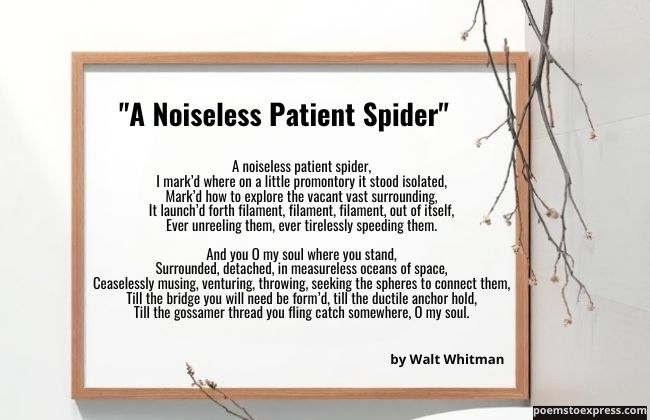
7) “Out of the Cradle Endlessly Rocking”
“Out of the Cradle Endlessly Rocking” is a poem that showcases Walt Whitman’s distinctive free verse style and thematic complexity.
The poem narrates the story of a boy who confronts profound loss through the metaphor of a mockingbird’s sorrowful song. Whitman’s use of rich imagery and layered language in the poem serves to evoke emotion and contemplate the themes of memory, nature, and the development of the poet’s own voice.
Whitman masterfully conveys his experience and personal growth by weaving the natural elements with human emotion.
The musicality of the piece—the flow of lines and alternating rhythm—mirrors the movements of the sea and contributes to the sense of a continuous journey, reinforcing the cyclic nature of life and the enduring process of self-discovery.
Out of the cradle endlessly rocking,
Out of the mocking-bird’s throat, the musical shuttle,
Out of the Ninth-month midnight,
Over the sterile sands and the fields beyond, where the child leaving his bed wander’d alone, bareheaded, barefoot,
Down from the shower’d halo,
Up from the mystic play of shadows twining and twisting as if they were alive,
Out from the patches of briers and blackberries,
From the memories of the bird that chanted to me,
From your memories sad brother, from the fitful risings and fallings I heard,
From under that yellow half-moon late-risen and swollen as if with tears,
From those beginning notes of yearning and love there in the mist,
From the thousand responses of my heart never to cease,
From the myriad thence-arous’d words, … See full poem
8) “The Wound-Dresser”
“The Wound-Dresser” emerges as one of Walt Whitman’s most poignant works, enveloping the grim realities of the Civil War.
Whitman crafts this piece from his experiences tending to injured soldiers, engaging readers with visceral imagery of the battlefield infirmaries. The poem is a deep exploration of pain, compassion, and human connection amid the chaos of war.
As the narrative unfurls, it reveals an elderly man recounting his days as a caregiver during the conflict. Whitman’s lines encapsulate the stark contrast between the glorification of war and the stark truths on the ground.
In each stanza, the poet’s words act as a quiet witness to suffering, bringing to light the tenderness that perseveres in times of despair.
An old man bending I come among new faces,
Years looking backward resuming in answer to children,
Come tell us old man, as from young men and maidens that love me,
(Arous’d and angry, I’d thought to beat the alarum, and urge relentless war,
But soon my fingers fail’d me, my face droop’d and I resign’d myself,
To sit by the wounded and soothe them, or silently watch the dead;)
Years hence of these scenes, of these furious passions, these chances,
Of unsurpass’d heroes, (was one side so brave? the other was equally brave;)
Now be witness again, paint the mightiest armies of earth,
Of those armies so rapid so wondrous what saw you to tell us?
What stays with you latest and deepest? … See full poem
9) “There Was a Child Went Forth”
The poem explores the formation of a child’s identity through his daily interaction with his environment.
Each object, person, or experience the child encounters is incorporated into his being, broadening his perception of the world and of himself.
This process symbolizes the formative influence of the environment on the individual and the merging of the self with the universe, reflecting Whitman’s vision of unity and the intrinsic connection between human beings and nature.
The poem uses a cataloging technique, where various experiences and observations of the child, from natural elements to social interactions, are listed to illustrate how they are integrated into his identity.
Through this approach, Whitman captures the essence of life and its universal character, without distinctions or barriers, promoting a vision of inclusion and mutual understanding.
There was a child went forth every day,
And the first object he looked upon and received with wonder or pity or love or dread, that object he became,
And that object became part of him for the day or a certain part of the day . . . . or for many years or stretching cycles of years.
The early lilacs became part of this child,
And grass, and white and red morningglories, and white and red clover, and the song of the phœbe-bird,
And the March-born lambs, and the sow's pink-faint litter, and the mare's foal, and the cow's calf, and the noisy brood of the barn-yard or by the mire of the pond-side . . and the fish suspending themselves so curiously below there . . . See full poem
10) “I Hear America Singing”
The poem celebrates the diversity and vitality of the American working spirit. Whitman portrays America as a chorus composed of different ‘carols’ sung by individuals from various professions, from mechanics to sailors, each contributing their unique voice to the whole of the country.
This collective song symbolizes the individuality and contribution of each person to the American dream, highlighting a sense of pride and community belonging.
Whitman uses this poem to express his optimism and his belief in the strength and dignity of common work, seeing in each labor a form of art and an expression of personal identity.
I hear America singing, the varied carols I hear,
Those of mechanics, each one singing his as it should be blithe and strong,
The carpenter singing his as he measures his plank or beam,
The mason singing his as he makes ready for work, or leaves off work,
The boatman singing what belongs to him in his boat, the deckhand singing on the steamboat deck,
The shoemaker singing as he sits on his bench, the hatter singing as he stands,
The wood-cutter’s song, the ploughboy’s on his way in the morning, or at noon intermission or at sundown,
The delicious singing of the mother, or of the young wife at work, or of the girl sewing or washing,
Each singing what belongs to him or her and to none else,
The day what belongs to the day—at night the party of young fellows, robust, friendly,
Singing with open mouths their strong melodious songs.
Understanding Walt Whitman’s Literary Style
Free Verse and Its Impact
Walt Whitman is often heralded as the father of free verse in poetry, a form that he employed with great effect.
Free verse is characterized by its lack of consistent meter and rhyme, allowing the poet greater freedom to express thoughts and emotions. Whitman’s application of this style broke away from traditional, structured forms of poetry that were dominant in the literary world of his time.
His seminal work, Leaves of Grass, showcases this free-flowing form, mimicking the organic patterns of natural speech. One can observe a powerful rhythmic cadence through the use of repetition and parallelism even in the absence of a strict rhyme scheme.
The impact of Whitman’s free verse was profound, influencing generations of poets by demonstrating that the rhythm of human experience does not need to fit into a predetermined pattern to resonate deeply with readers.
Themes of Nature and Humanity
Walt Whitman’s poetry persistently intertwines the themes of nature and humanity, reflecting his beliefs in their fundamental connection.
- Nature: His poems often include detailed and celebratory presentations of the natural world, from blades of grass to the endless sky. Whitman viewed nature as a mirror to the human soul, a source of wisdom, and a place for the spiritual and the physical to coalesce.
- Humanity: Equally prominent in Whitman’s work is his focus on the self and the collective human spirit. He wrote extensively about the individual experience, democratic ideals, and the importance of personal connection.
Exploring Whitman’s Influence on American Poetry
Cultural and Historical Context
Walt Whitman emerged during a time when America was grappling with its identity, both culturally and politically. His masterpiece, “Leaves of Grass,” was released at the intersection of the Romanticism movement, which celebrated individualism, and the impending conflict of the Civil War.
Whitman’s work is synonymous with the concept of a democratic and inclusive America, a theme that resonated deeply within the fabric of the nation during the mid-19th century.
- Timeframe: Mid-1800s, height of Romanticism, approaching Civil War
- Key Themes: Democracy, individualism, inclusivity
- Significance: Reflecting and shaping American ideals during a transformative period
Legacy in Modern Literature
The ripple effects of Whitman’s poetry can be identified in the works of many 20th-century poets. He is frequently cited as a pioneer in the use of free verse, inspiring modernist poets who sought to break traditional constraints.
Notably, Allen Ginsberg, a prominent figure of the Beat Generation, acknowledged Whitman’s influence. Ginsberg’s poem “A Supermarket in California” serves as a direct homage to Whitman, echoing his themes and stylistic nuances.
- Pioneering Free Verse: Paved the way for modernist exploration of form and structure.
- Beat Generation: Acknowledgment and adaptation of Whitman’s style, particularly by Allen Ginsberg.
- Enduring Impact: Continues to inspire contemporary literary discourse and creative expression.
You might also like:

